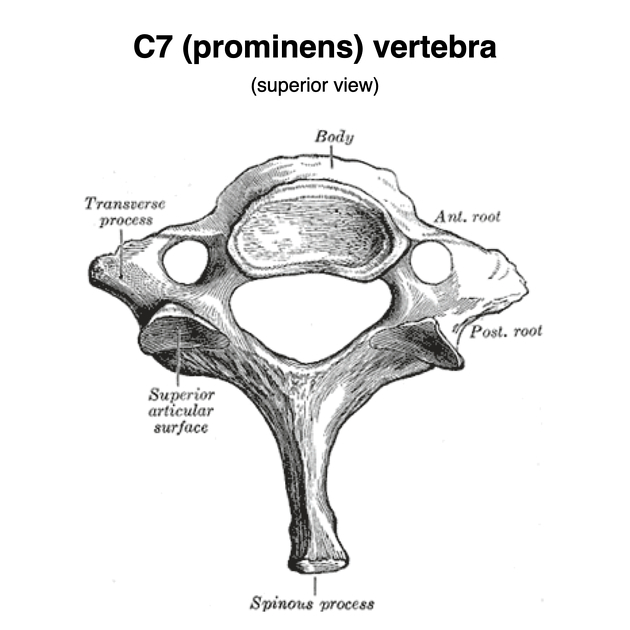Cervical spine
Citation, DOI, disclosures and article data
At the time the article was created Tim Luijkx had no recorded disclosures.
View Tim Luijkx's current disclosuresAt the time the article was last revised Henry Knipe had the following disclosures:
- Integral Diagnostics, Shareholder (ongoing)
- Micro-X Ltd, Shareholder (ongoing)
These were assessed during peer review and were determined to not be relevant to the changes that were made.
View Henry Knipe's current disclosures- Cervical vertebra
- Cervical vertebrae
- C-spine
- C-spines
- Cervical spines
The cervical spine (often shortened to C-spine) is the upper part of the spine extending from the skull base to the thorax at the level of the first vertebra with a rib attached to it. It normally consists of seven vertebrae. Its main function is to support the skull and maintain the relative positions of the brain and spinal cord. It also provides a pathway for the vertebral arteries and veins to carry blood to and from the brain via the transverse foramina.
For a basic description of the anatomy of a generic vertebra, see vertebrae.
Gross anatomy
Although C1 (atlas) and C2 (axis) have unique characteristics and C7 (also termed vertebra prominens) deviates from the overall pattern, general characteristics of the cervical vertebrae include:
- small, oval-shaped vertebral bodies
- relatively wide vertebral arch with large vertebral foramen
- small, triangular vertebral canal
- relatively long, bifid (except for C7) inferiorly pointing spinous processes
- transverse foramina protecting the vertebral arteries and veins
A more detailed description can be found in the article on typical cervical vertebrae.
Quiz questions
References
- 1. Martini F, Ober WC, Garrison CW et-al. Fundamentals of anatomy & physiology. Prentice Hall College Div. ISBN:0130172928. Read it at Google Books - Find it at Amazon
Incoming Links
- Nasopharyngeal cancer (staging)
- Annular fissure
- CT lumbar spine (protocol)
- CT cervical spine (protocol)
- Deep layer of the deep cervical fascia
- Cervical spine (lateral view)
- Typical cervical vertebrae
- External carotid artery
- Cervical spine floating pillar
- Cervical spine protocol (MRI)
- Levator claviculae
- Lordosis
- CT neck (protocol)
- Vertebra
- Whiplash syndrome
- Scalene muscles
- Intertransverse ligaments
- Thoracic spine
- Cervical spine series
- Cervical rib
- Atlanto-occipital dissociation
- Odontoid fracture
- Normal cervical spine (CT)
- Normal CT cervical spine
- Multilevel cervical spondylosis
- Normal MRI cervical spine - including T2 sagittal oblique sequences
- Chronic dens fracture
- Hair on end sign
- Cervical nerve root levels (illustration)
- First cervical vertebrae (Gray's illustration)
- Normal MRI cervical spine
- Accessory articulation between cervical transverse processes
- Malpositioned central venous line in a vertebral vessel
- Lateral spine anatomy (Gray's illustration)
- Vertebra prominens (Gray's illustration)
- Atlas (Gray's illustration)
- Axis (Gray's illustration)
- Block vertebra
- Normal cervical spine MRI
- Bilateral Sprengel deformity with Klippel-Feil syndrome
Related articles: Anatomy: Spine
-
osteology
- vertebrae[+][+]
- spinal canal
- cervical spine
- thoracic spine[+][+]
- lumbar spine[+][+]
- sacrum
- coccyx
-
anatomical variants[+][+]
- vertebral body
- neural arch
- transitional vertebrae
- ossicles
- ossification centers
- intervertebral disc[+][+]
- articulations[+][+]
- ligaments[+][+]
- musculature of the vertebral column[+][+]
- muscles of the neck
- muscles of the back
-
suboccipital muscle group
- rectus capitis posterior major muscle
- rectus capitis posterior minor muscle
- obliquus capitis superior muscle
- obliquus capitis inferior muscle
- splenius capitis muscle
- splenius cervicis muscle
- erector spinae group
- transversospinalis group
- quadratus lumborum muscle
-
suboccipital muscle group
- spinal meninges and spaces[+][+]
-
spinal cord[+][+]
- gross anatomy
-
white matter tracts (white matter)
- corticospinal tract
- anterolateral columns
- lateral columns
-
dorsal columns
- fasiculus gracilis (column of Goll)
- fasiculus cuneatus (column of Burdach)
- grey matter
- nerve root
- central canal
- functional anatomy
- spinal cord blood supply
- sympathetic chain[+][+]













 Unable to process the form. Check for errors and try again.
Unable to process the form. Check for errors and try again.